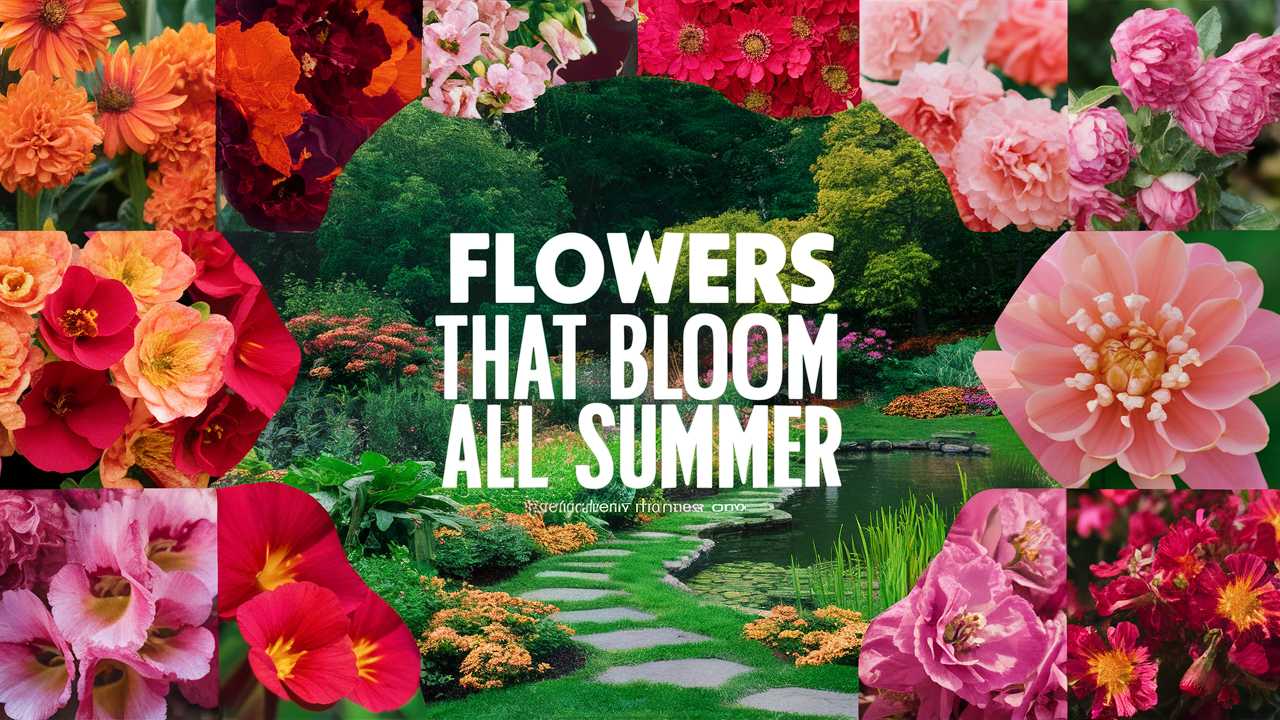In this guide, we’ll explore some exceptional summer flowers, delving into their unique characteristics, beauty, and care. Let’s embark on a journey through the blooming wonders of summer!
Allium

Allium is often synonymous with elegance in the garden. Known for its spherical clusters of tiny flowers atop tall, slender stems, this member of the onion family provides visual interest to any summer landscape. Available in various species, Allium giganteum produces majestic purple globe-shaped flower heads that can reach up to 6 inches in diameter.
Alliums are hardy and drought-resistant, making them a great choice for gardeners looking for low-maintenance options. These perennials thrive in full sun and well-drained soil, and they attract a variety of pollinators, including bees and butterflies, which adds even more life to your garden. Plant them in groups for dramatic effect, as their unique structure creates noteworthy contrast against other flowering plants.
Astilbe
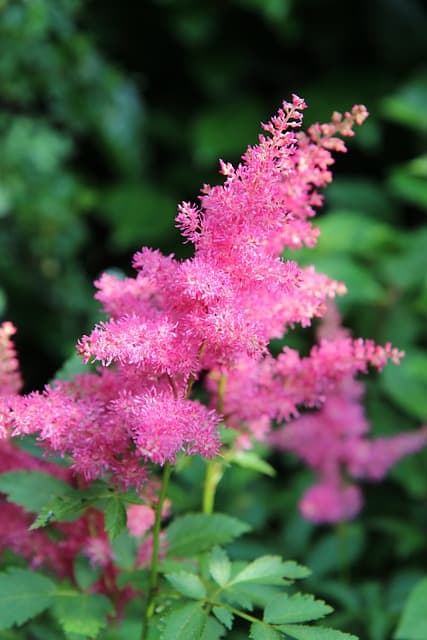
Astilbe is a beautiful perennial that shines in the summer garden, particularly in partial shade. With feathery, plume-like flowers ranging from white to shades of pink, red, and lavender, these plants add a soft touch to any landscape. Beyond their attractive blooms, Astilbes are valued for their fern-like foliage, which remains lush and appealing even when not in bloom.
These flowers thrive in consistently moist soil and can enhance the beauty of shaded areas or edges of water features. If you’re looking to create a serene garden that stays vibrant throughout the summer, Astilbe is an excellent addition. The combination of its fine texture and varied bloom colors will catch the eye and provide a backdrop for other summer flowers.
Autumn Joy Stonecrop
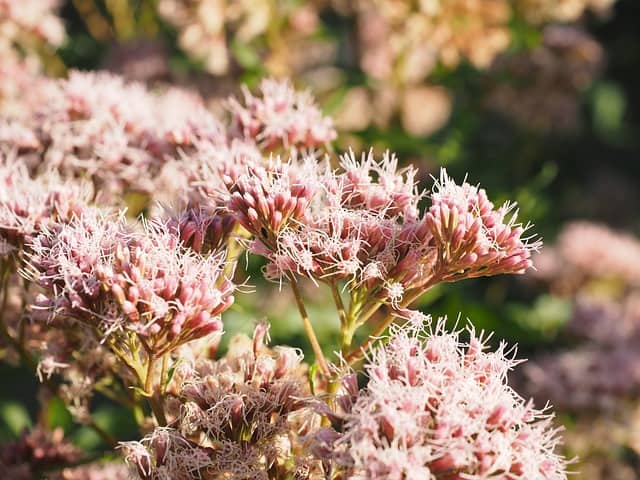
Despite its name, the Autumn Joy Stonecrop is a summer-stalwart that produces wonderful clusters of blooms in hues of pink and copper that deepen to a rich rust as summer transitions to fall. This succulent perennial, with its fleshy leaves, is drought-tolerant and thrives in well-drained soil, making it an ideal plant for gardens focusing on water conservation.
What makes Autumn Joy particularly special is its ability to attract butterflies and other beneficial insects. You can place them in full sun or light shade to maximize their growth and display. Don’t be surprised if you find this low-maintenance gem becoming the centerpiece of your late-summer garden!
Bee Balm (Monarda)

Bee Balm, or Monarda, is renowned for its vibrant and frilled blooms that resemble fireworks—often found in shades of red, pink, purple, and white. This perennial not only captivates the eyes but also earns its name as a magnet for pollinators, particularly bees, butterflies, and hummingbirds. Bee Balm brings a lively buzz of activity to any summer garden.
Plant Bee Balm in a sunny location, and you will enjoy the ongoing blooms from early summer through the fall. Its fragrant leaves can be used in herbal teas, making it a two-for-one beauty in your garden! The unique shape and bold colors of the flowers make it a perfect companion plant alongside other summer-blooming species, creating a vibrant tapestry of life.
Black-Eyed Susan (Rudbeckia)
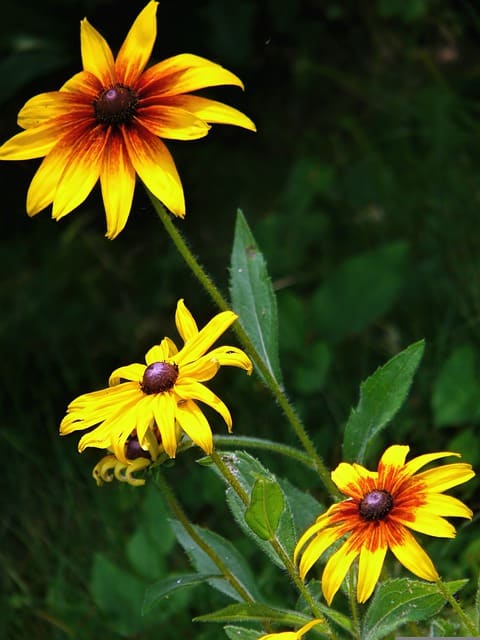
Black-Eyed Susan is the quintessential symbol of summer gardens. With their bright yellow petals and dark brown central cones, these flowers embody warmth and cheer. They bloom from late spring through fall, making them a steadfast choice for long-lasting color in your outdoor spaces.
This versatile perennial thrives in a range of soil types and is incredibly drought-resistant once established. Black-Eyed Susans are an essential addition to cottage gardens and are perfect for attracting butterflies and songbirds. Their bold color also pairs beautifully with other summer flowers, ensuring that your garden is alive with diverse colors and textures.
Blanket Flowers
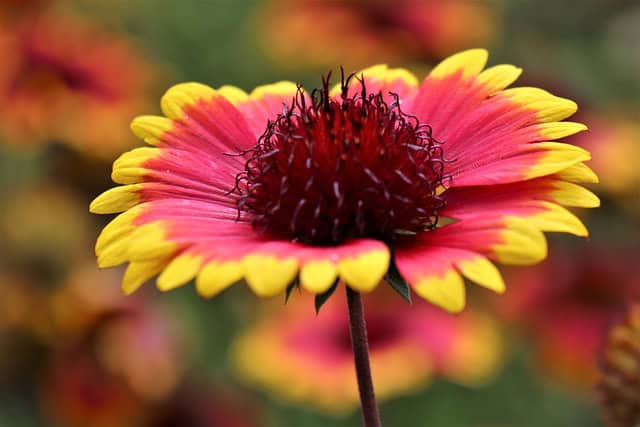
Adding a splash of color to any garden, Blanket Flowers (Gaillardia) are eye-catching perennials that flourish from early summer to fall. These blooms shine in bright reds, yellows, and oranges, resembling a sunset. Their unique petal pattern and semi-double flowers create a mesmerizing visual effect.
These flowers thrive in well-drained soil and love full sun. They are also drought-tolerant, making them perfect for gardeners who may not have the time to water frequently. The long-lasting blooms of Blanket Flowers make them a favorite for pollinators, drawing in bees and butterflies throughout the season.
Bleeding Heart
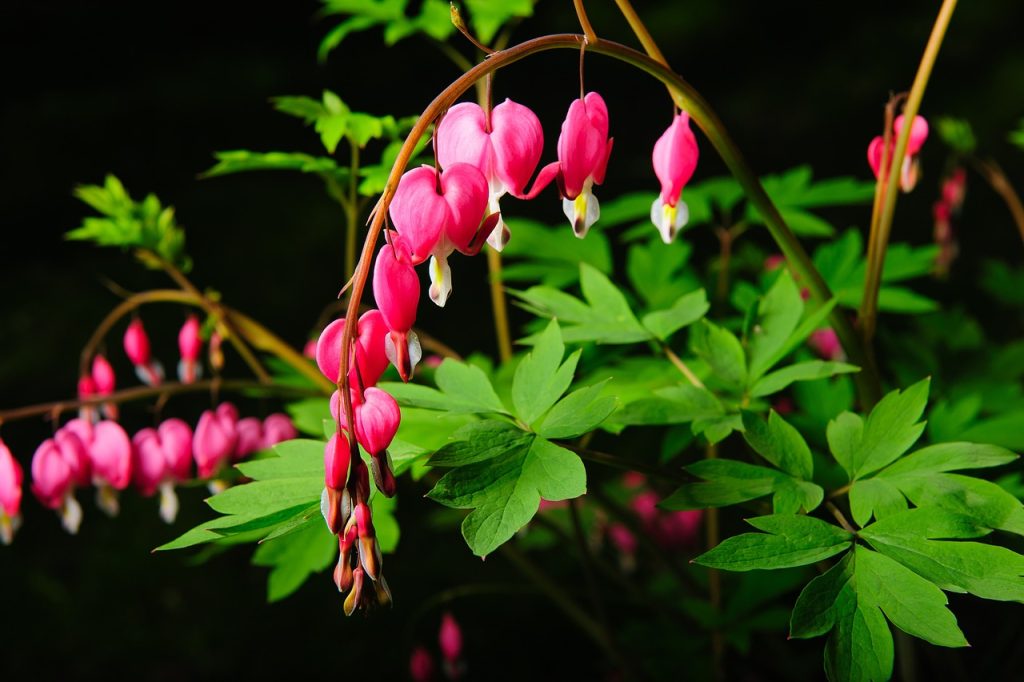
With its heart-shaped, pink flowers delicately draping from arching stems, the Bleeding Heart (Dicentra) captures the imagination. These plants, which bloom from late spring to summer, add a touch of romance to shaded garden corners.
Bleeding Hearts thrive in cooler, moist conditions and will perform best in partial shade. They can be a bit more high-maintenance as they require consistent watering to keep their lush foliage looking its best. The unique shape and color of these flowers make them stand out beautifully among other summer varieties, making them excellent for mixed borders or as focal points in shady spots.
Bugleweed
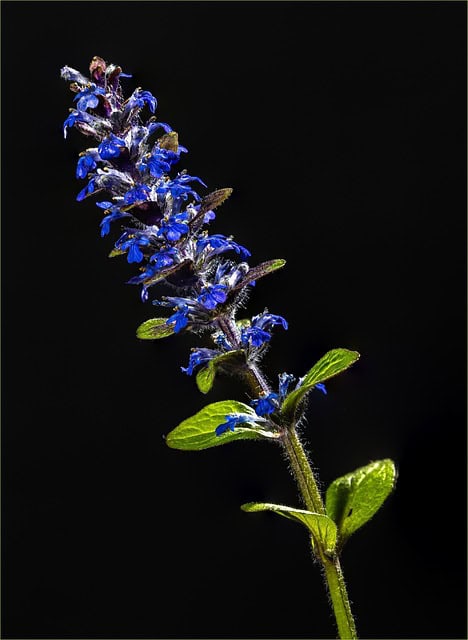
Often overlooked, Bugleweed (Ajuga) is a charming ground cover that blooms in early to mid-summer. With clusters of deep blue flowers rising from rosettes of glossy green leaves, this perennial is perfect for filling in gaps and creating a lush carpet of color.
Bugleweed prefers partial shade and moist soil, making it suitable for woodland gardens or shaded borders. As a low-growing plant, it works well as a filler between taller flowers, adding a touch of contrast and depth to your summer garden. Its low maintenance and ability to outcompete weeds make it a practical choice for busy gardeners.
Bush Clockvine

The Bush Clockvine (Thunbergia alata) is a beautiful tropical perennial that adds a stunning dynamic to summer gardens with its tubular flowers in orange and yellow, often featuring dark centers. This fast-growing vine can ascend trellises, fences, or walls, creating a cascading display of color during the hotter months.
Best suited for full sun, the Bush Clockvine thrives in well-drained soil and is relatively low-maintenance, making it wonderful for smaller gardens desiring vertical growth. Its charming flowers attract hummingbirds and butterflies, making it not only an ornamental delight but an active participant in the summer ecosystem.
Catmint (Nepeta racemosa)

Adding a soft blue hue to your summer garden, Catmint (Nepeta racemosa) is a perennial powerhouse that thrives in sunny spots. Blooming from late spring to early fall, these aromatic plants generate a lush display of lavender-blue flowers that are irresistible to pollinators.
Catmint is drought-tolerant and thrives in well-drained soil, making it a low-maintenance choice for busy gardeners. Its fine, airy foliage pairs beautifully with bolder blooms, creating an elegant layered effect in your landscape. Beyond its beauty, Catmint is known to repel certain pests, providing an added layer of protection for your garden.
Clematis
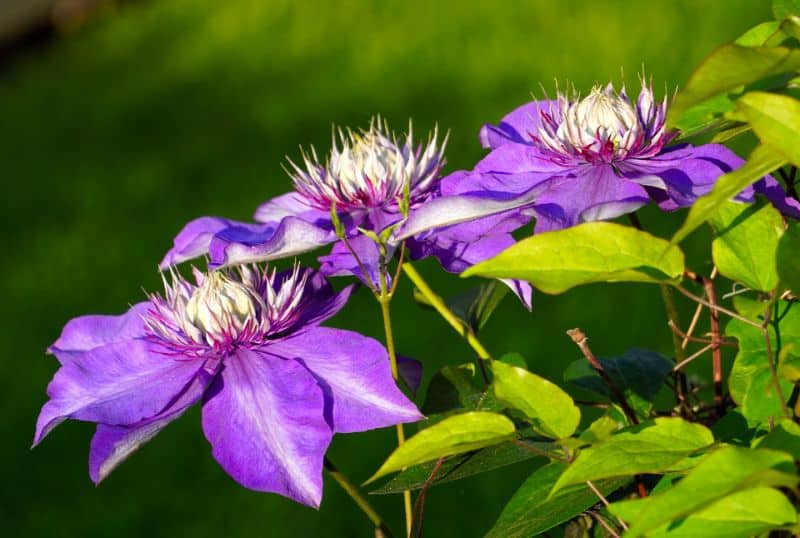
Clematis is often revered as the “queen of climbers.” With its expansive variety of species, blooming colors, and forms, this vine can provide dramatic displays throughout the summer. Their flowers can be single or double, showcasing stunning shades of pink, purple, white, and blue, and they can climb trellises, fences, and even trees.
Clematis thrives in full sun, but needs its roots to be shaded, so mulching is beneficial. They are moderately low-maintenance; deadheading spent blooms encourages continued flowering throughout the summer months. Featuring both vertical accents and colorful drapes, Clematis can elevate the aesthetic of any garden, encouraging exploration and admiration.
Coneflower (Echinacea)
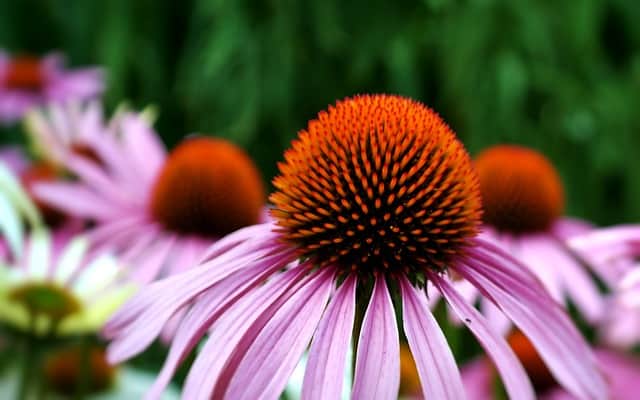
The Coneflower is a classic summer garden staple with its daisy-like blooms in a host of beautiful colors, including pink, purple, and white. These robust perennials bloom from early summer to fall, imparting their charm and resilience to gardens everywhere.
Known for being drought-resistant and easy to grow, Coneflowers prefer full sun and well-drained soil. They have gained popularity not only for their beauty but also for their medicinal properties, often used in herbal remedies. Their ability to attract butterflies and support local ecosystems only adds to their appeal, ensuring that your summer garden remains lively and vibrant.
Coreopsis
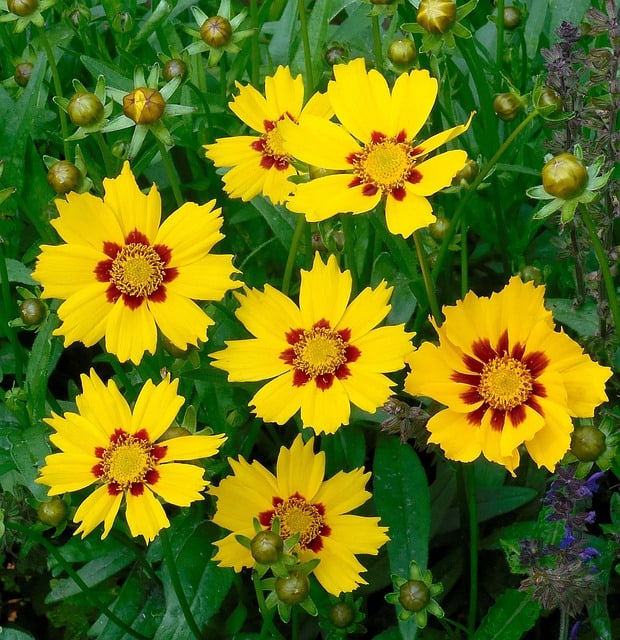
Known for its cheerful yellow flowers, Coreopsis (also known as Tickseed) blooms profusely from early summer through the fall. This perennial produces numerous daisy-like blooms that can brighten any garden with their infectious color.
Coreopsis thrives in full sun and is drought-tolerant, thriving even in lean, sandy soils. Its long blooming period and ability to attract pollinators make it a must-have for summer gardens. With its easy-going nature and vibrant display, Coreopsis will easily find a home in your landscape, providing joy each time you step outside.
Dahlia
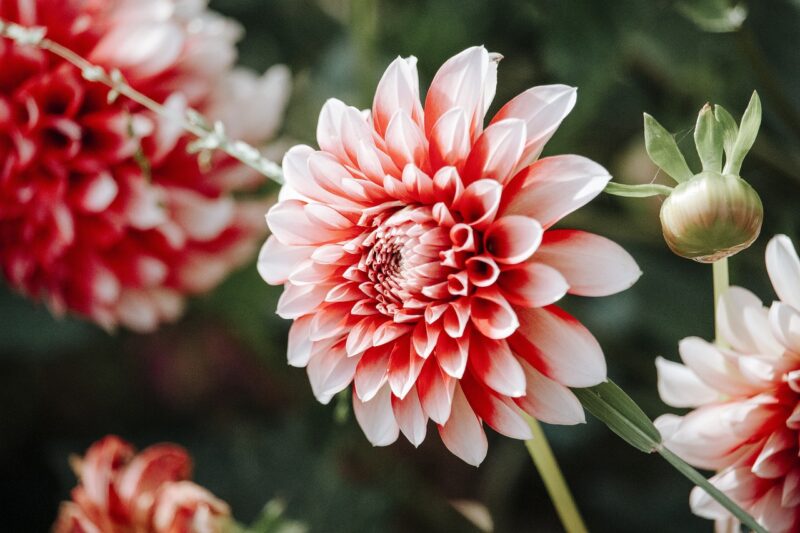
Dahlias are known for their stunning diversity in form and color. Ranging from petite pom-pom shapes to elegant dinner-plate sizes, these tuberous perennials bring phenomenal splashes of color to gardens during the summer months. Blooms come in virtually every shade you can imagine, making them versatile contenders in any floral display.
Although Dahlias require a bit more care—such as staking taller varieties and regular deadheading—they are certainly worth the attention they require. They prefer full sun and rich soil, and they will bloom from mid-summer to the first frost. Their elegance and grandeur will undoubtedly catch the eyes of anyone strolling through your garden.
Daylilies (Hemerocallis)
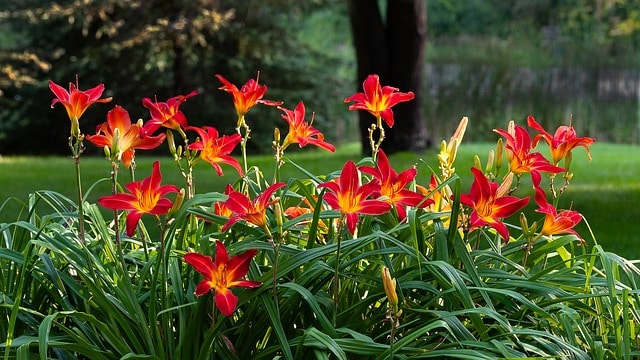
Celebrated for their abundant flowers and resilience, Daylilies bloom with vibrant, trumpet-shaped blossoms that can range from yellow to orange to deep red. Each flower typically lasts only one day, but the plant produces a profusion of buds that ensure a long bloom period throughout the summer.
Daylilies are adaptable, thriving in a variety of soil types and conditions. They do well in full sun but can tolerate partial shade, making them a flexible addition to any garden design. With minimal care and their ability to naturalize, they’re perfect for busy gardeners looking to build a stunning yet low-maintenance landscape.
Dianthus
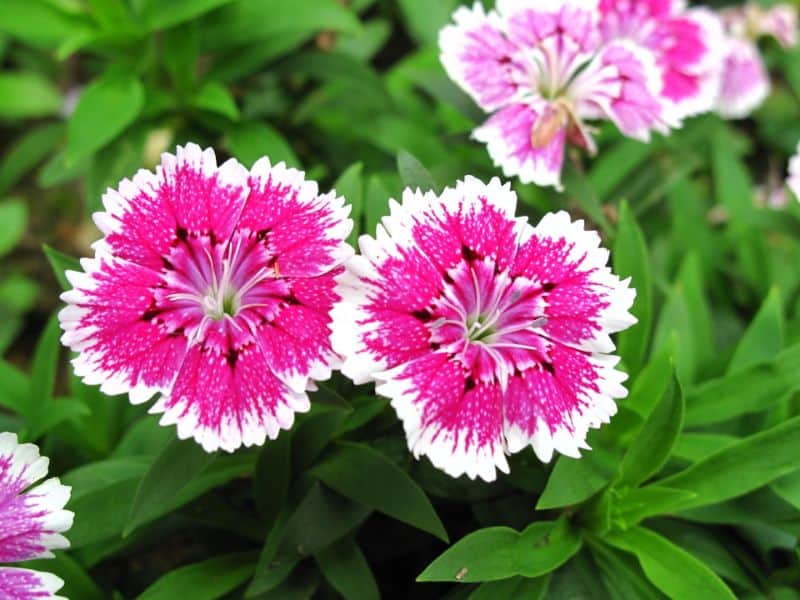
Dianthus includes various species, often referred to as “pinks” or “carnations.” These charming flowers boast a fragrance that delights and can bloom in various colors, including soft pinks, whites, and deep reds. Their frilled petals and compact growth habit make them ideal for borders, containers, or as ground cover.
These perennials thrive in sunny locations and well-drained soil. They are fairly hardy and can tolerate drought, making them an easy addition to a summer garden. The soft bloom of Dianthus, coupled with its sweet scent, can add a romantic touch that can charm anyone wandering through.
Foam Flower
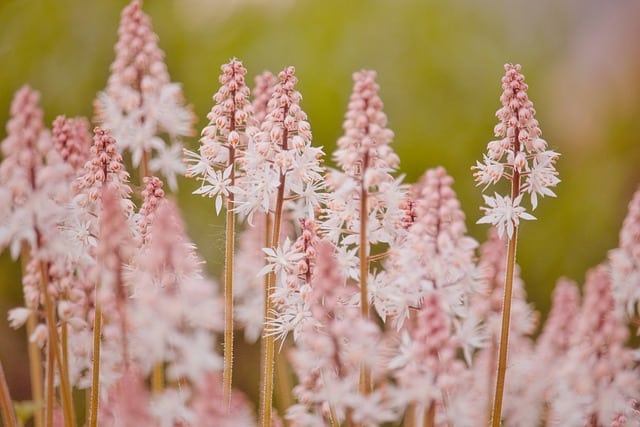
Foam Flower (Tiarella) provides a delightful addition to shaded summer gardens. With its delicate white or pink spikes of flowers atop low foliage, this perennial offers a whimsical touch to the landscape.
Foam Flowers thrive in moist, well-drained soil and can flourish in part to full shade. Their foliage displays attractive shapes that remain appealing after flowering, creating texture throughout the growing season. This versatile plant can effectively cascade over borders or function as a filler, making it a fantastic choice for enhancing your garden’s visual layers.
Fringed Bleeding Heart
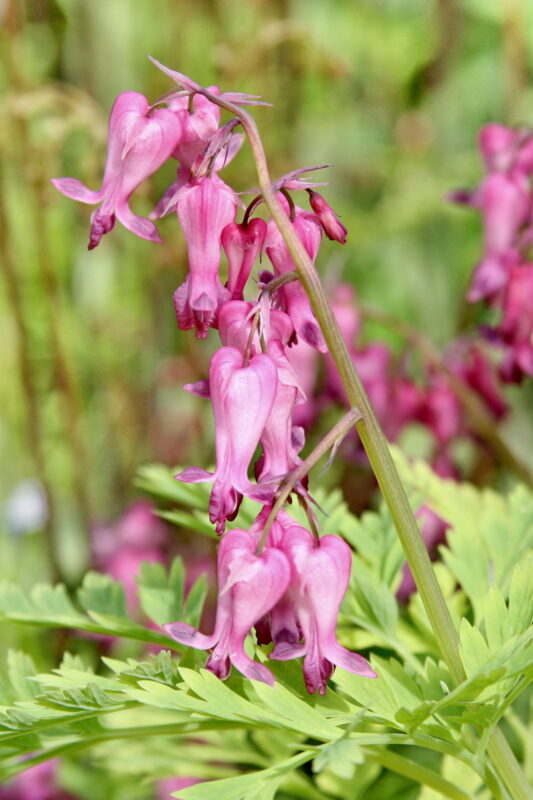
Closely related to the traditional Bleeding Heart, the Fringed Bleeding Heart (Dicentra eximia) offers unique, finely cut leaves and delicate, fringed, heart-shaped pink flowers. This perennial blooms later in spring and continues through the summer months, providing a lush, romantic aesthetic in shady areas.
Fringed Bleeding Heart prefers moist, well-drained soil and partial to full shade. Adding these flowers to your garden will create a soft and enchanting space, ideal for retreat. They will thrive with minimal care, rewarding you with their graceful blooms for many summers to come.
Geranium
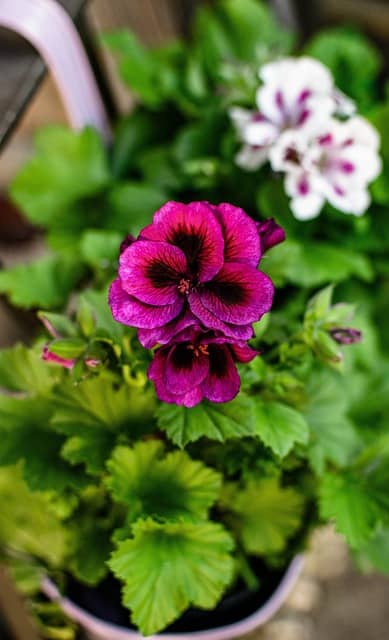
Geraniums are beloved for their bright, cheerful flowers and sprawling habit. These hardy perennials thrive in sunny areas and can showcase blooms in various colors, from pinks and purples to crisp whites.
Geraniums are adaptable, tolerating different soil types and providing low-maintenance options for gardeners. Their ability to create ground cover, compete with weeds, and attract pollinators makes them a practical yet delightful addition to summer gardens. Regardless of your garden’s theme, geraniums add texture and vibrant colors that can uplift your outdoor space.
Hibiscus
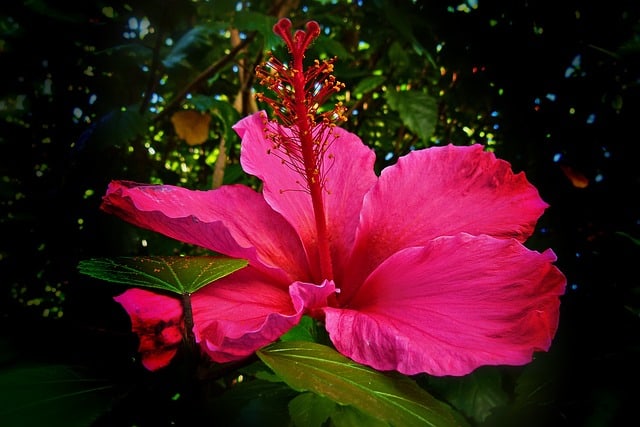
The tropical Hibiscus is a show-stopper during the summer months. Known for its large and colorful blooms, often in shades of red, pink, and yellow, Hibiscus flowers are sure to create a bold impact in any garden.
These tropical plants enjoy the sun and thrive in well-drained soil. Regular watering and feeding will encourage their magnificent blooms to reach their full potential. With their eye-catching flowers, Hibiscus serves as a dramatic centerpiece in summer landscapes, adding flair and tropical vibes to your garden.
Hollyhocks
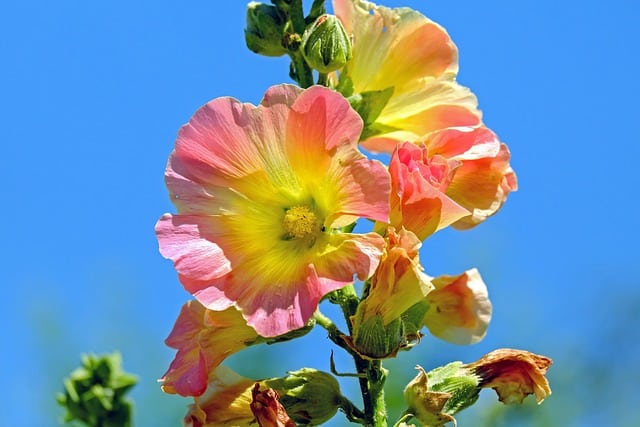
Hollyhocks are tall, stately biennials that bring a touch of nostalgia and old-world charm to any summer garden. Their towering spikes can reach impressive heights and are adorned with large, colorful blooms, creating a striking focal point.
Hollyhocks prefer full sun and enjoy rich, well-drained soil with consistent moisture. Their classic appearance makes them a favorite for cottage gardens and mixed borders. They bloom from early summer into fall, providing a seasonal highlight that evokes the beauty of traditional gardens.
Hydrangeas
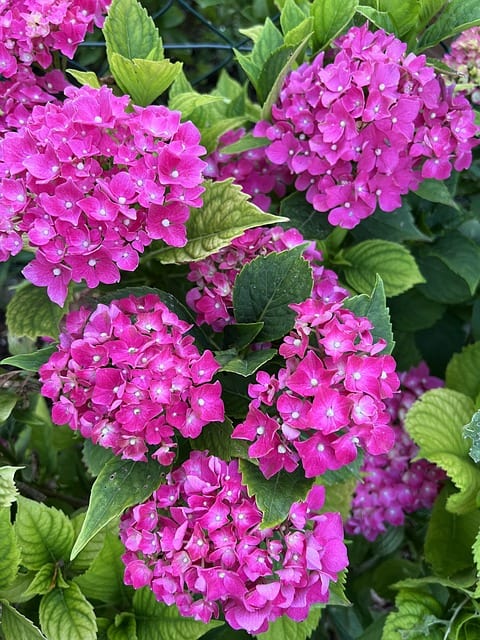
Hydrangeas are a beloved choice for summer gardens due to their lush, globe-like blooms that can range in color from soft pastels to vibrant hues. They create stunning displays and are often seen in garden landscapes as focal points or border plants.
These shrubs thrive in partial sun and prefer well-drained, rich soil. They require regular watering and can be pruned after blooming to manage their size. With their remarkable colors and dramatic presence, hydrangeas lend an air of sophistication and beauty to summer gardens, inviting admiration and tranquility.
Ice Plant (Delosperma cooperi)
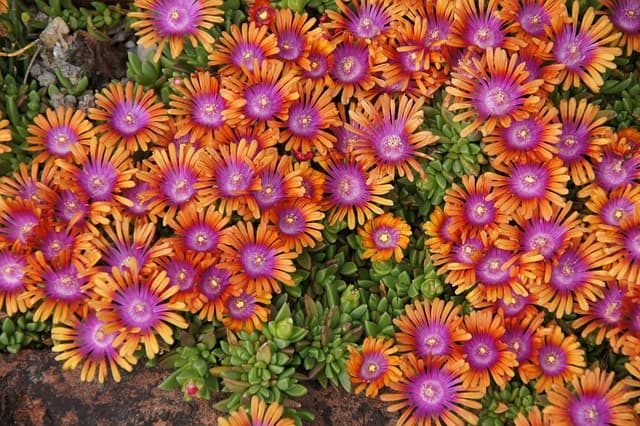
Ice Plant is a unique succulent that thrives in sunny and xeriscaped gardens. With its fleshy, shimmering leaves and vibrant daisy-like flowers in shades of pink and yellow, it’s a drought-resistant option that delivers both beauty and practicality.
These hardy plants prefer well-drained soil and can flourish in poor conditions, making them perfect for rock gardens or tough spots. Ice Plants bloom from late spring to late summer, spreading their vivid colors across your landscape. Whether in borders or hanging baskets, they bring a refreshing sparkle to your summer garden with their unmistakable charm.
Lantana

Lantana is a tropical sensation that transforms any garden into a vibrant paradise. Known for its clusters of small, brightly colored flowers, Lantana produces blooms in hues of orange, yellow, pink, and purple throughout the summer. This flowering plant is particularly loved by butterflies and hummingbirds, making it a must-have for pollinator gardens.
Lantanas are incredibly adaptable, thriving in hot and dry conditions while preferring full sun. Their drought-resistant nature, alongside fragrant foliage, adds an appealing aroma to your garden space. Plant them in pots, borders, or as ground cover for a riot of color that brings joy and life all summer long.
Lavender
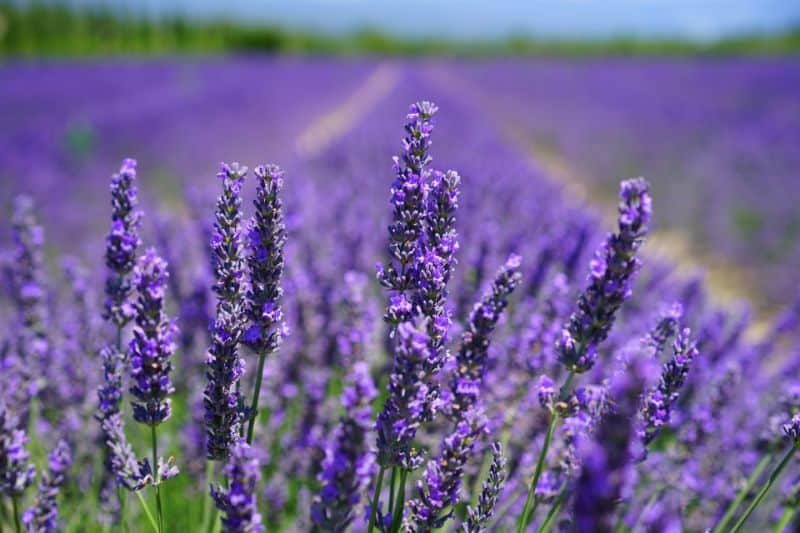
Lavender is not only prized for its soothing fragrance but also for its stunning purple spikes that signal the arrival of summer. Known for its versatility, lavender fills gardens with a delightful aroma and attracts bees, butterflies, and beneficial insects.
This hardy perennial thrives in well-drained soil and full sun, showing resilience in drought conditions. Beyond its beauty, lavender has a host of uses, from culinary applications to essential oils and sachets. Whether planted in rows or as a border, lavender is a timeless choice that embodies tranquility and grace in the summer landscape.
Lilyturf
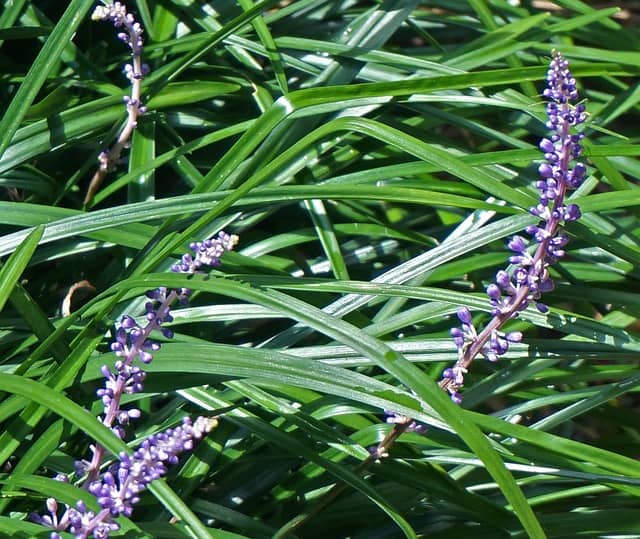
Lilyturf (Liriope) is an underestimated beauty in the perennial world, characterized by its lush grass-like foliage and delicate purple flower spikes. Blooming in late summer, these arching spikes create a visually soothing contrast in gardens.
Lilyturf thrives in a variety of conditions, from full sun to partial shade, and adapts well to different soil types. This hardy plant is excellent for filling in gaps or as a path border, providing texture and interest. Its minimalist appeal and reliability make it a favorite for gardeners aiming for a low-maintenance yet elegant aesthetic.
Lupine

Lupines are a vibrant and visually striking addition to any summer garden, with their tall, spiky blooms that can showcase a range of colors, including blue, purple, red, and white. Known for their dainty blossoms arranged in clusters, Lupines can bring a charming touch to borders and mixed plantings.
These perennials prefer well-drained soil and full sun but can tolerate some shade. They are also noteworthy for attracting bees and other pollinators, incorporating life and movement into your garden. With their vertical growth habit and abundant bloom display, Lupines can provide stunning focal points amidst other summer flowers.
Marigold (Tagetes)
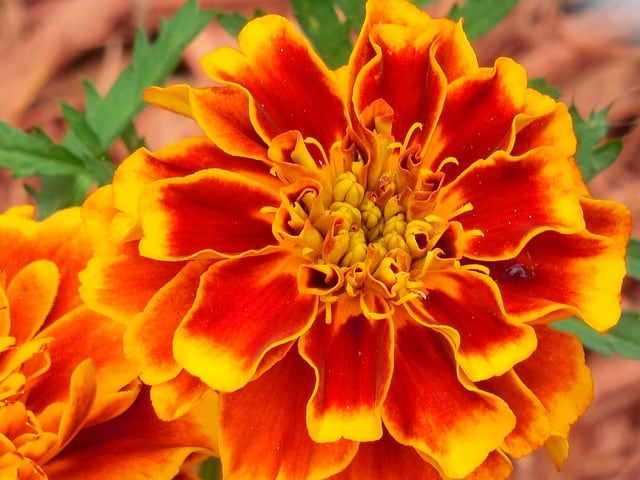
Marigolds are spirited annuals known for their bright, cheerful blooms that range from yellow to deep orange. They bloom profusely from early summer until the first frost, making them a staple in vibrant gardens. Their simple beauties and ability to withstand heat and drought make them a popular choice among gardeners.
Beyond aesthetics, marigolds serve practical purposes; they repel pests and can enhance the growth of nearby plants. They are perfect for borders and containers, infusing outdoor spaces with sunny color and a joyful vibe. Their low maintenance requirement makes them ideal for beginners or those looking for low-effort yet impactful gardening options.
Peonies
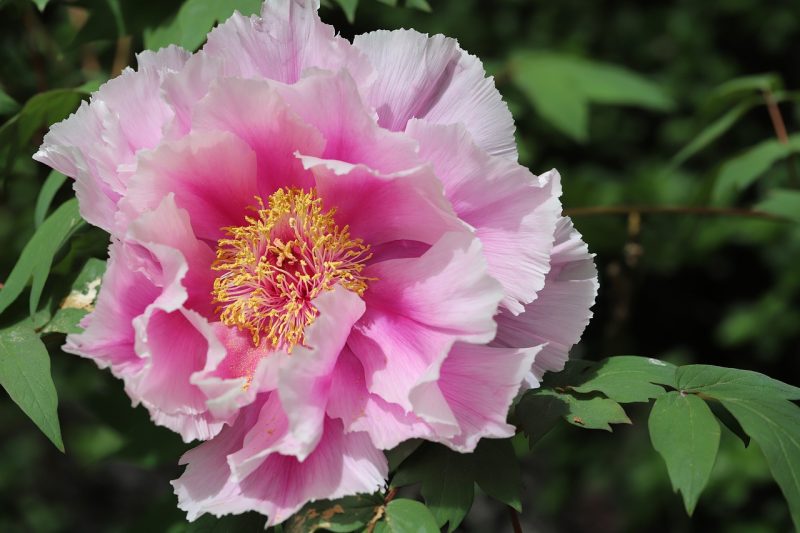
Peonies are the epitome of summer elegance with their full, lush blooms and intoxicating fragrance. Ranging from soft whites and pinks to deep burgundies, peonies are among the most beloved perennials in many gardens. Their plush petals create an opulent texture that adds depth and richness to any floral arrangement or landscape.
Peonies prefer well-drained soil and a sunny location for optimal blooms. While they bloom in late spring and early summer, their foliage remains lush and attractive throughout the summer. With a long lifespan, these perennial treasures become cherished highlights in gardens, often passed down through generations.
Petunia
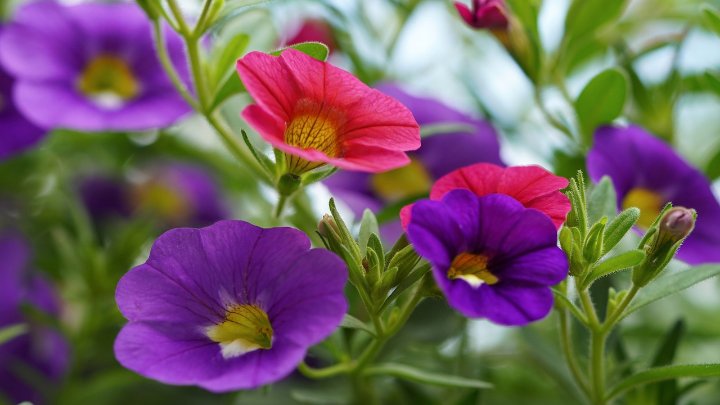
Petunias are iconic summer flowers that come in an impressive array of colors and patterns, making them a favorite for containers, hanging baskets, and garden beds. They bloom continuously from late spring to the first frost, bringing joy and vibrancy to any space.
These tender annuals prefer full sun and well-draining soil, and they require regular watering to maintain their lush appearance. Petunias can be single-flowered or ruffled, and their ability to withstand heat and drought makes them reliable bloomers for summer gardens. Their cheerful blooms can transform even the simplest outdoor spaces into lively scenes.
Phlox
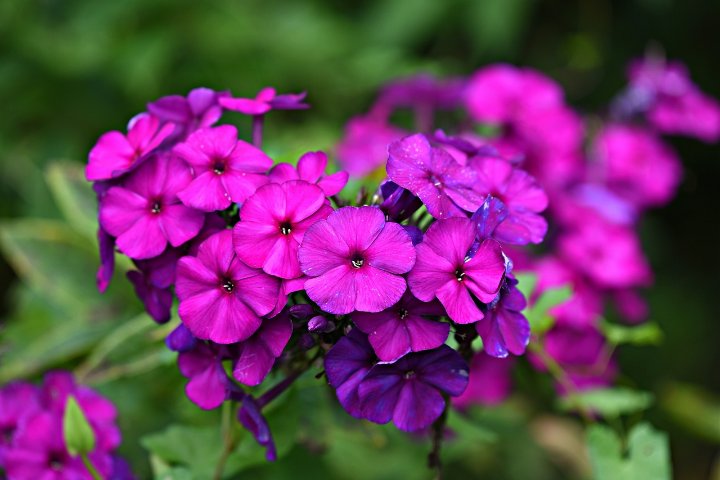
Phlox offers a delightful and fragrant addition to any summer garden with its clusters of star-shaped flowers in a spectrum of shades, including pink, purple, white, and red. Blooming from early summer through fall, these perennials attract butterflies and hummingbirds, adding movement and life to your garden.
They thrive in full sun to partial shade and benefit from well-drained soil. Deadheading spent blooms will encourage further flowering, ensuring your garden remains colorful for longer. With their charming profile and pleasant fragrance, Phlox is a perfect choice for borders and perennial beds.
Red Hot Poker
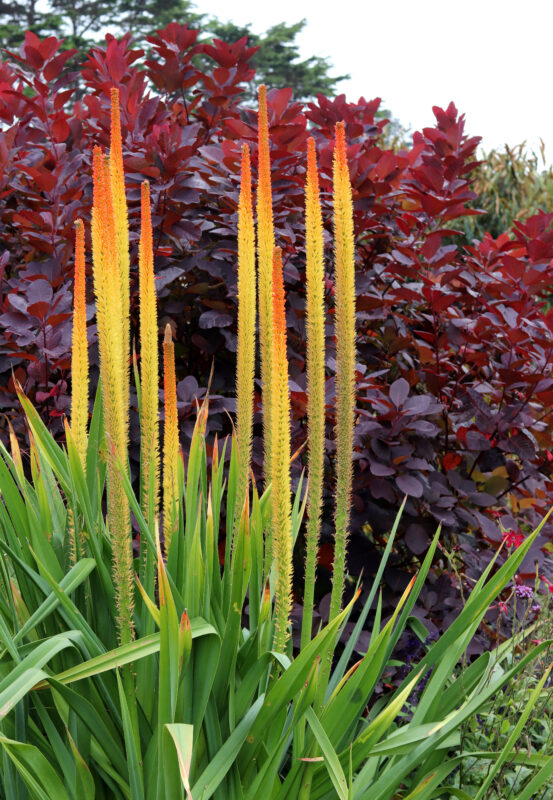
Red Hot Poker, or Kniphofia, is a striking plant featuring tall spikes of tubular flowers that radiate bright orange and yellow hues throughout the summer months. Resilient and heat-loving, these dramatic plants command attention and add unique architectural interest to gardens.
Red Hot Poker prefers full sun and well-drained soil and is fairly drought-tolerant once established. Their unique flower structure and ability to attract pollinators make them an excellent choice for wildlife gardens. Plant these fantastic perennials in drifts to create bold visual statements in your landscape.
Rose of Sharon (Hibiscus syriacus)
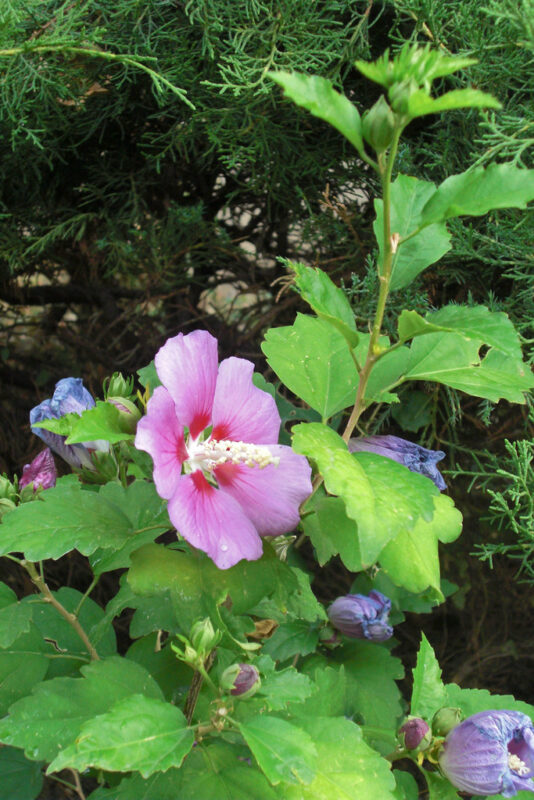
This enchanting shrub features beautiful blooms in shades of white, pink, and purple. Rose of Sharon offers a profusion of flowers that bloom from mid-summer to fall, providing a late burst of color in your garden just when other flowering plants begin to fade.
This hardy plant prefers full sun and thrives in a variety of soil types, making it versatile in garden design. With its ability to attract hummingbirds and butterflies, Rose of Sharon adds not just beauty but also life to your yard. Its lovely flowers can stand alone in a shrub border or be combined with other summer-bloomers for a fantastic display.
Roses
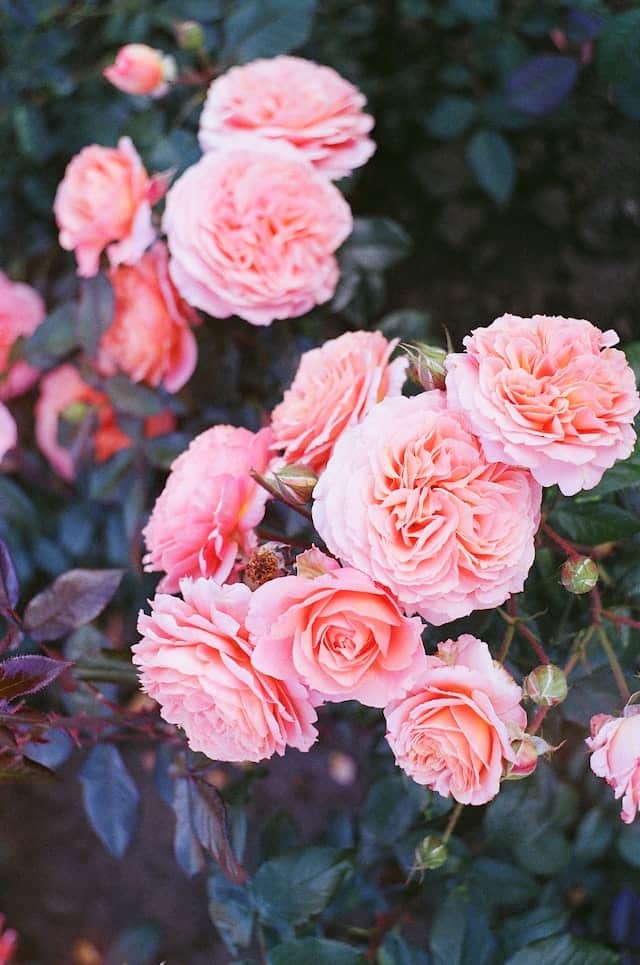
Roses are the classic symbols of love and beauty, and for good reason! Their stunning blooms and delightful fragrance make them perennial favorites in any summer garden. Available in countless varieties— from climbing and bush to miniature—roses bloom in endless shades, from pastel pinks and whites to deep reds.
Roses thrive in sunny locations, requiring well-drained soil and regular watering to produce the best blooms. While they may require a bit more care, including pruning and pest monitoring, the result is a breathtakingly beautiful garden filled with luscious, fragrant flowers that enchant all who pass by.
Rudbeckia
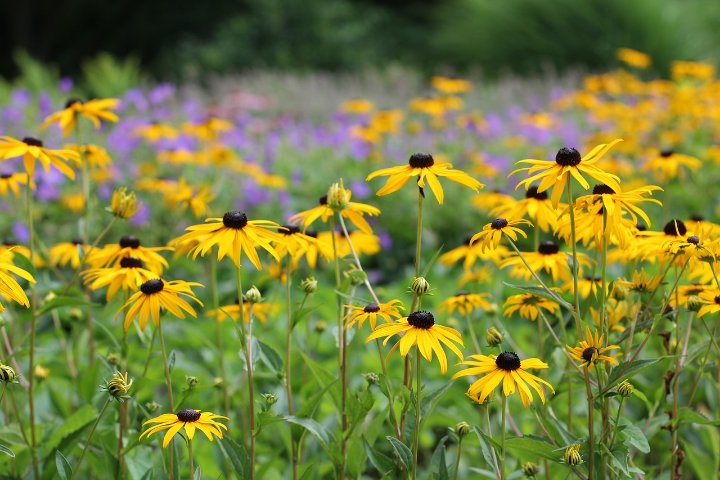
Commonly known as Black-Eyed Susan, Rudbeckia is a cheerful summer flower characterized by its bright yellow or orange petals and dark central cones. These vibrant blooms are not only beautiful but also incredibly hardy, blooming from early summer until fall and attracting various pollinators, including bees and butterflies.
Rudbeckia flourishes in full sun and is tolerant of different soil types, including clay. They are low-maintenance, drought-tolerant once established, and can easily naturalize in a garden. Their striking colors and long blooming period make them prized additions to summer flower beds, borders, or wildflower gardens.
Russian Sage
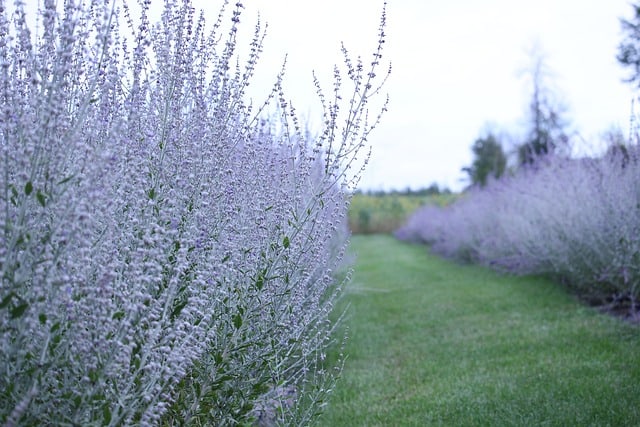
Russian Sage (Perovskia atriplicifolia) is a drought-resistant perennial that brings a soft lavender hue to summer gardens. Its feathery, silvery foliage complements the tall spikes of small, fragrant flowers that bloom from mid-summer through fall, creating a feeling of serenity in the landscape.
Preferring full sun and well-drained soil, Russian Sage is versatile and low-maintenance, making it a great choice for gardeners looking for beautiful plants that won’t require too much care. Its airy texture and subtle colors make it an excellent companion to bolder flowers, adding balance to your garden.
Sedum Voodoo
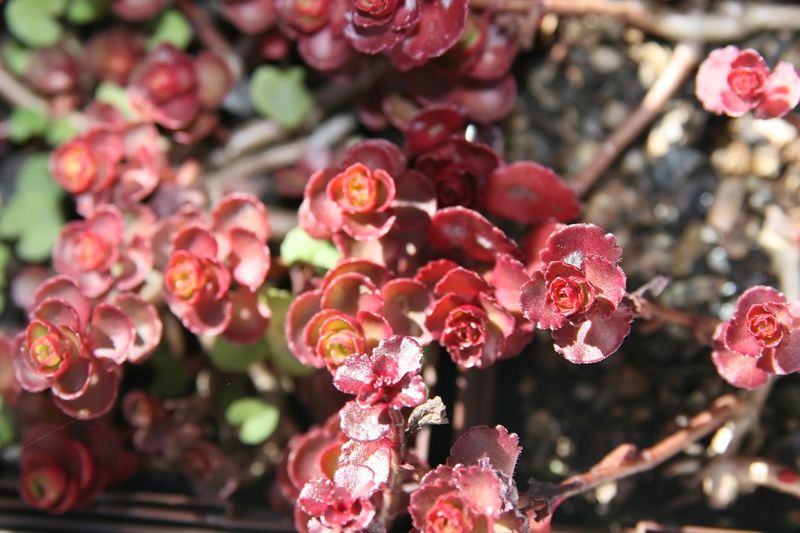
Sedum Voodoo is a captivating succulent perennial that brings a modern touch to the summer garden. Its dark, almost black foliage creates stunning contrast against its vibrant clusters of star-shaped flowers, which bloom in shades of red and pink. Blooming from late summer to fall, Sedum Voodoo showcases a remarkable visual display.
This drought-tolerant plant thrives in full sun and poor soil, making it a low-maintenance option for busy gardeners. Its unique appearance allows it to shine in rock gardens or as a striking addition to mixed beds. This versatile plant not only enhances your summer garden’s beauty but also supports local pollinators.
Serbian Bellflower
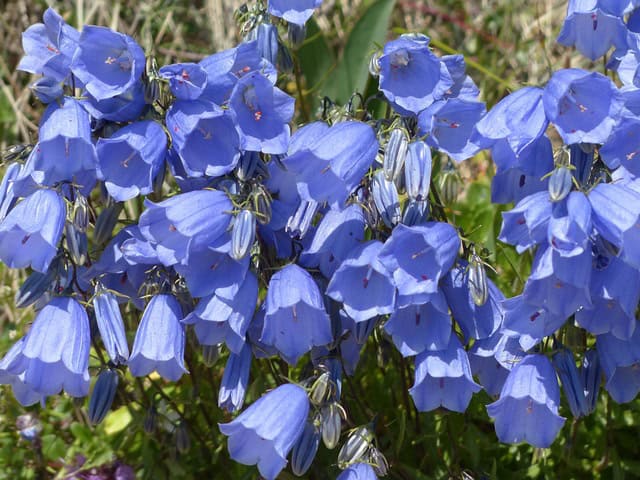
Serbian Bellflower (Campanula poscharskyana) is a charming perennial that offers a cascade of delicate, bell-like flowers in shades of violet-blue. Blooming from early summer to early fall, these charming blossoms create a lovely carpet of color, ideal for borders or as ground cover.
Serbian Bellflower thrives in part shade to full sun, with well-drained soil, and is relatively low-maintenance. Its spreading habit makes it perfect for filling in spaces and draping over walls or containers. The soft hues and gentle blooms are perfect for creating a peaceful, cottage-garden feel.
Shasta Daisy
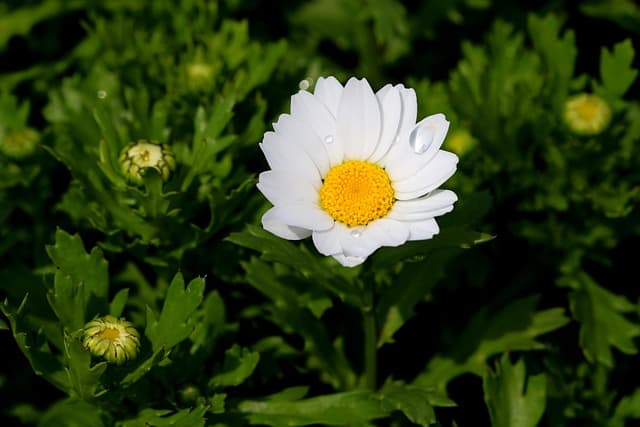
Shasta Daisies are a charming and classic choice for summer gardens, with their white petals and yellow centers creating a cheerful display. These easy-to-grow perennials start blooming in early summer and continue to thrive until the first frost, attracting butterflies and adding liveliness to the garden.
Shasta Daisies prefer full sun and well-drained soil, though they can tolerate various conditions. Their robust nature makes them an excellent addition to mixed borders, perennial beds, or wildflower gardens. With their classic charm and ability to blend beautifully with other summer flowers, Shasta Daisies are a must-have for any season.
Snapdragon (Antirrhinum majus)
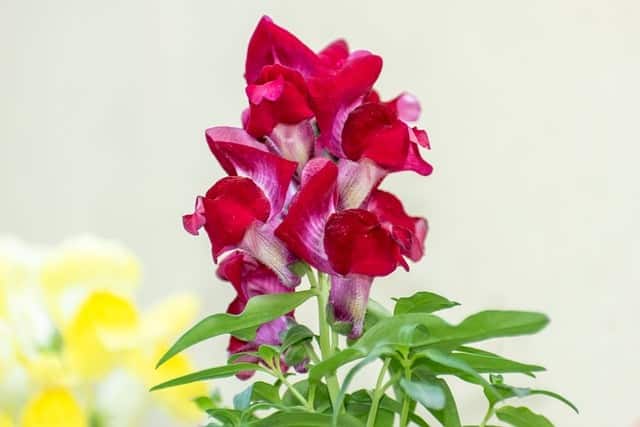
Snapdragons are charming annuals that bloom from early summer until the first frost, showcasing delightful, tubular flowers in a kaleidoscope of colors. Their unique structure and upright growth habit create whimsical vertical elements in flower beds and containers.
These colorful blooms prefer full sun to partial shade and thrive in well-drained soil. Snapdragons have a lovely fragrance and are magnets for bees and butterflies, adding life to your garden. With a relatively easy care routine and stunning timeless aesthetics, Snapdragons enhance any summer setting.
Speedwell (Veronica longifolia)
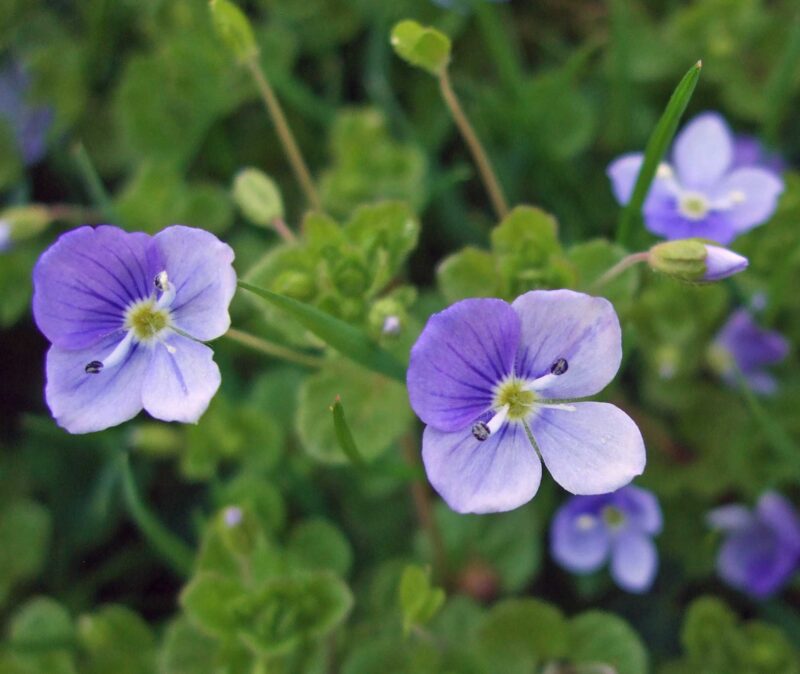
Speedwell features tall spikes of small, tubular flowers that bloom in shades of blue and purple during the summer months. Known for its charming profile and lush green foliage, this perennial adds vertical interest to garden beds and borders.
Speedwell thrives in full sun to partial shade and prefers well-drained soil. They are drought-tolerant once established, making them a suitable option for eco-friendly gardeners. The delicate flowers attract pollinators, creating lively interactions in your garden as butterflies and bees dance among the blooms.
Spider Lily
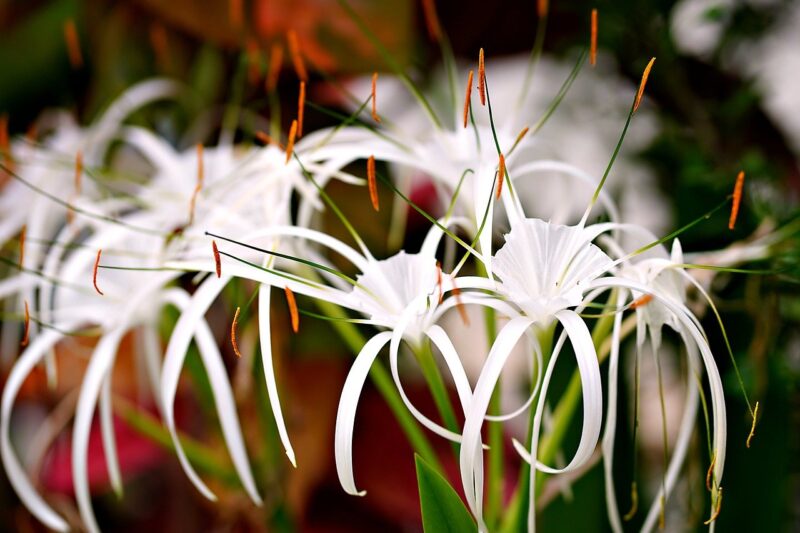
Spider Lilies (Hymenocallis) stand out with their distinctive, long, strappy petals that twist and curl elegantly, forming an eye-catching bloom. These exotic flowers add a tropical flair, and while they typically bloom in late summer, their striking appearance is unforgettable.
These perennial bulbs thrive in moist, well-drained soil and enjoy full sun to partial shade. Spider Lilies can easily adapt to garden environments or as container plants, offering a unique aesthetic and attracting pollinators to your space. Their dramatic blooms can create a stunning focal point, enhancing the beauty of your summer garden.
Stonecrop (Sedum)
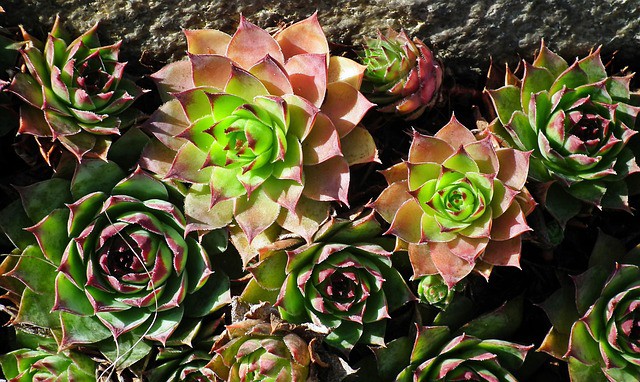
Stonecrop encompasses various succulent species known for their sturdy, fleshy leaves and clusters of star-shaped flowers in hues of yellow, pink, and red. These hardy perennials bloom throughout the summer, making them a perfect choice for xeriscaping or rock gardens.
Highly drought-tolerant, Stonecrop prefers well-drained soil and enjoys full sun. Their compact habit and low-maintenance nature make them ideal for busy gardeners looking to add vibrant colors and textures to their landscape. They offer a resilience that is beautifully paired with softer plants, creating stunning contrasts that elevate summer aesthetics.
Vinca
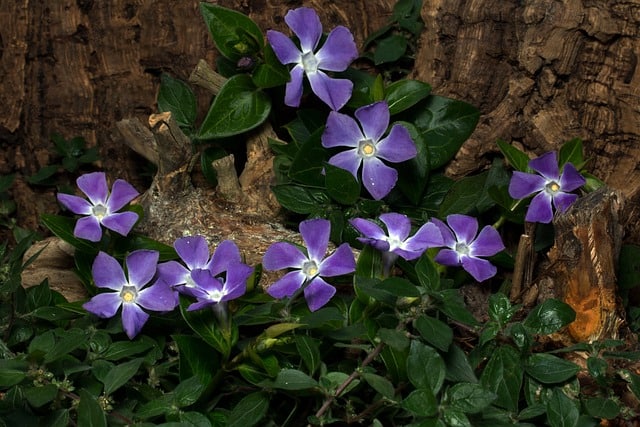
Vinca, a lovely ground cover, features glossy, dark green leaves and delicate, star-shaped flowers that bloom from spring through frost. Its flowers come in shades of blue, pink, purple, and white, providing colorful coverage to the garden floor.
Vinca thrives in partial sun to full shade, making it perfect for brightening up darker areas of your garden. Drought-tolerant once established, it is a low-maintenance choice that can effectively suppress weeds. Vinca excels in containers, hanging baskets, and as a carpet for borders, ensuring your summer space remains vibrant throughout the season.
Yarrow (Achillea millefolium)

Yarrow is well-known for its resilience and long-lasting blooms that appear in summer gardens with their flat-topped clusters of tiny flowers in bright yellows, pinks, and whites. Not only does this perennial bloom prolifically, but it also attracts beneficial insects, including bees and butterflies.
Thriving in full sun, Yarrow prefers well-drained soil and is drought-tolerant, making it a fitting candidate for low-maintenance gardens. Its fragrant foliage and sturdy stature make it an excellent addition to borders, wildflower gardens, or mixed beds. With its beautiful blooms and ability to attract wildlife, Yarrow brings both beauty and ecological benefits to summer gardens.
Zinnia
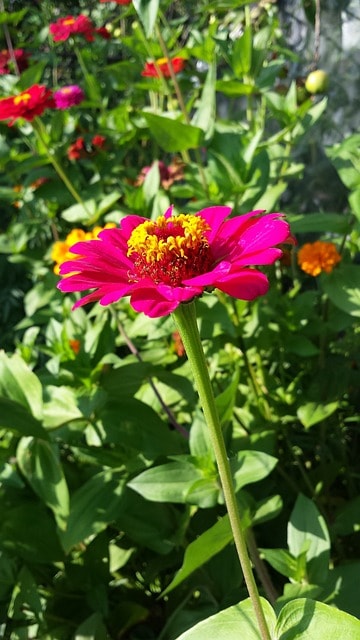
Zinnias are beloved annuals that boast a dazzling array of colors and forms, blooming from late spring through fall. Their large, cheerful blooms come in every color of the rainbow, making them a favorite choice for gardens brimming with life and color.
Zinnias thrive in sunny spots and are highly adaptable to various soil types. They are also known for attracting butterflies and are perfect for cut flower arrangements. Their ability to bloom continuously through the summer and require minimal maintenance makes them perfect for both novice and seasoned gardeners who wish to create a vibrant and lively atmosphere.


